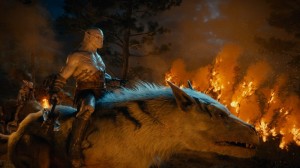THE HOBBIT NEEDED A LURTZ

The lines of good and evil in Game of Thrones are very blurred. Khal Drogo is a ruthless warlord and we know the barbaric things this man is done, however as a character he is redeemed by his love and devotion to his wife Danaerys. Azog has none of these redeeming factors, nor does he need them. He is the villain whom we’re not supposed to like.
Peter Jackson often expressed how Fellowship of the Ring was tricky because Sauron and Saruman stayed in their towers the whole time. The character of Lurtz, the captain of the Uruk-hai sent to capture the hobbits (invented for the film, I might add), provided the filmmakers a physical villain for the movie that our heroes could actually fight. He was a specific orc who we could grow to hate and who added gravitas to Boromir’s death.
As Lurtz snarls and aims that last arrow point blank at Boromir’s face, the audience is seething. As Aragorn jumps in to save the day and has the visceral showdown with Lurtz, the audience is treated to a climactic fight. I still cheer every time Aragorn lops his head off. An Unexpected Journey, without Azog, once again lacked that central villain. Smaug was miles away and not even revealed in this film. The Trolls, the Goblin King and even Gollum are incidental characters and challenges that the Company encounters along the way. No build-up was required, nor would it make sense.
AN UNEXPECTED CLIMAX

By the time they’ve gone beyond Mirkwood, Bilbo has driven off the spiders single-handedly and organised the escape of the dwarves through the barrels. Once coming to shore, having half-drowned in the barrels, you can imagine Thorin saying:
“You! What were you doing? You nearly got yourself killed! Did I not say that you would be a burden? That you would not survive in The Wild? And you had no place amongst us? And I have never been so wrong in all my life!”
Because, at this point, Bilbo has proven his courage. The dwarves have begun to look to him as a leader. And it is indeed here, in the book, that Bilbo and Company first set eyes on the Lonely Mountain which again reinforces my theory that this scene was first intended to be the closing scene of An Unexpected Journey.
We have one major problem however by transplanting this scene to where it ended up; Bilbo had not yet proven himself to the dwarves. The result is a contrived, rushed climax.
My least favourite part of An Unexpected Journey is the point where all the dwarves are stranded out on the tree dangling over the edge of the cliff. Thorin and Azog spot each other and Thorin thinks:
“Oh yeah, I forgot we need a showdown at the end of this film!”
He gets up and runs back to face Azog with some very forced slow-motion shots and a very out-of-place Ringwraiths Theme attempting to make this the film’s most impressive scene.
At least it is realistic how Azog and his white warg quickly dispense with the tiny Thorin (still, the less said about a mace to the face causing only a broken lip, the better). Then the film falls into painful cliché as Azog gets one of his henchmen to slowly bring him the dwarf’s head leaving a convenient opening for Bilbo to save Thorin’s life.
It still induces a little roll of the eyes every time I watch it. After such a great film, it falls at that last hurdle. Whether Azog was always going to be there is questionable; I almost get the feeling that he was shoe-horned in, along with some more of those Azog scenes to give An Unexpected Journey a Lurtz-style character.


